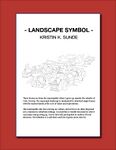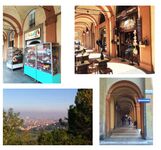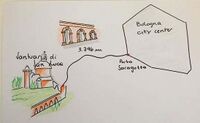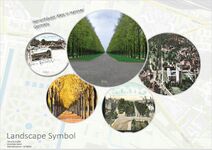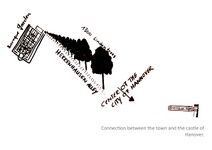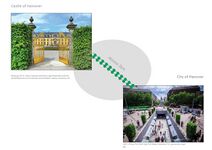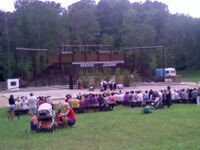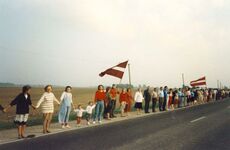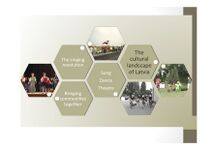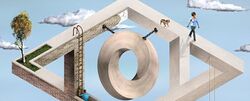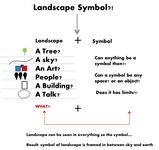LED Seminar 2016 - Landscape Symbols Reflection Group D: Difference between revisions
| (13 intermediate revisions by 4 users not shown) | |||
| Line 25: | Line 25: | ||
''in addition to your initial visual please add two further analytical drawings of your symbol'' | ''in addition to your initial visual please add two further analytical drawings of your symbol'' | ||
<gallery caption=" " widths="200px" heights="150px" perrow="3"> | <gallery caption=" " widths="200px" heights="150px" perrow="3"> | ||
Image: | Image:ThePorticoesofSanLuca2.jpg|slide 1 | ||
Image: | Image:Analitico.jpg|slide 2 | ||
Image:groupI_slide3.JPG|slide 3 | Image:groupI_slide3.JPG|slide 3 | ||
</gallery> | </gallery> | ||
| Line 36: | Line 36: | ||
*What do these symbols mean to you today? Are they meaningful to more than just one cultural group? Are they shared across cultures? | *What do these symbols mean to you today? Are they meaningful to more than just one cultural group? Are they shared across cultures? | ||
'' | ''The Porticoes of San Luca was built in the XVII sec AC and is the longest in the world ( 3.8 km). It goes from the Arco Bonaccorsi at Porta Saragozza to the top of Colle della Guardia where is situated the Santuario di San Luca, pilgrimage site. While all other porticoes in Bologna were born from the necessity of more living space in buildings, these were built with the aim to protect pilgrims from the rain and cold. | ||
In years, under the arcade, shops and artisan laboratories filled up the ground floor of buildings meantime the city was expanding and houses were build all around the porticoes, next to via Saragozza. Today the porticoes are still full of shops, grocery, cafés and little restaurant and crowded with people walking at any time of the year protected by the sun and rain. The arcade are also walked by runners and curious tourist who trade the whole path till the Santuario to visit it and enjoy the view. | |||
I walk under the San Luca porticoes every day to go to University or to the city center and I find it very comfortable and traditional. People love to shop at the grocery or relax at the cafés because it make them feel part of the culture. Everyone could feel the warm atmosphere and live at all an important historical heritage.'' | |||
== Landscape Symbol 3- Süntelbuche/Herrenhausen Theresia Hupfer == | == Landscape Symbol 3- Süntelbuche/Herrenhausen Theresia Hupfer == | ||
| Line 66: | Line 70: | ||
<gallery caption=" " widths="250px" heights="150px" perrow="3"> | <gallery caption=" " widths="250px" heights="150px" perrow="3"> | ||
Image:Pic 0723 096.jpg|Village life in Latvia | Image:Pic 0723 096.jpg|Village life in Latvia | ||
Image:Figure2.jpg|The Baltic Way | Image:Figure2.jpg|The Baltic Way: Photo: P. Šķiņķis | ||
File: | File:Graphic representation village life.jpg|Singing, dancing and theatre, part of the cultural landscape of Latvia: Photos courtesy of R. Hazelden, K. Roth and P. Šķiņķis | ||
</gallery> | </gallery> | ||
| Line 77: | Line 81: | ||
''add your text here'' | ''add your text here'' | ||
Up and down the country of Latvia in many small towns and villages you will see a stadium where local song, dance and theatre festivals are held. Song and dance festivals have been held in Latvia for many years and even Soviet repression did not silence the inhabitants, instead they had to sing Soviet patriotic songs too. The song festivals became a rallying cry to Latvians to keep them together and a subversive way of defying the Soviet authorities. The singing revolution played an influential role in regaining independence. | |||
After independence there was freedom to sing there own traditional folk songs, dance their unique village dances and participate in theatre plays from their own past, all handed down over the years. Even though Latvia has struggled through two recessions after independence the tradition of song and dance still holds on. It is struggling as people migrate away from the villages and yet a country of around 2 million people can still produce high-class musicians and lead the world at the Choir games in 2014, where they won more gold medals than China, Russia, America and Indonesia. | |||
This stadium is in my own village down by the river and is still used during the local village festival in July. It is amazing to see all ages participating with a repertoire from the traditional to modern. The village may have a struggling economy, but people still come together to celebrate their traditions. | |||
== Landscape Symbol 5- All about space, Esra al Najjar == | == Landscape Symbol 5- All about space, Esra al Najjar == | ||
| Line 83: | Line 93: | ||
''in addition to your initial visual please add two further analytical drawings of your symbol'' | ''in addition to your initial visual please add two further analytical drawings of your symbol'' | ||
<gallery caption=" " widths="250px" heights="150px" perrow="3"> | <gallery caption=" " widths="250px" heights="150px" perrow="3"> | ||
Image:It's all about the space.jpg|It's all about the | Image:It's all about the space.jpg|It's all about the Space | ||
Image: | Image:Landscape Symbol in Everything.jpg|What is the Symbol? | ||
Image: | Image:Landscape Symbol in Frames.png|Which Frame is the Symbol? | ||
</gallery> | </gallery> | ||
| Line 94: | Line 104: | ||
*What do these symbols mean to you today? Are they meaningful to more than just one cultural group? Are they shared across cultures? | *What do these symbols mean to you today? Are they meaningful to more than just one cultural group? Are they shared across cultures? | ||
'' | ''''When I have read the assignment requirements, I have started looking into my environment. Both the refugee camp where I was born and raised or Germany, are spaces which I can pick landscape symbol from. However, in both spaces finding one symbol was not realistic. I have started asking myself what the meaning of symbol is? a symbol is defined briefly: something used for representing something else. This means a tree, a sky, an art, people, a building, a talk, a film and so on can all represent the word landscape. Personally, symbol is linked to a chain of emotional, cultural and personal experience. However, in my view, Landscape is represented in everything. Thus, the symbol is represented in everything, and its limits is between the sky and the earth '''' | ||
''''The meaning is changing as it is linked to the frame between the earth and sky, all the previous aspects, cultural, historical, environmental, socio-political and economic are the essence of creating the landscape thus creating the symbol. The symbol changes with changing the landscape, and the landscape is alive in every movement then the symbol is as well '''' | |||
''''It means to me as landscape is everything, the symbol is shared across history, cultures, countries. It is what we perceive and what we reflect. '''' | |||
== | == Comparing the shown symbols one can see that commonalities can be seen in each case, even though every symbol differs in either the location or the way it appears to people. Each symbol shows a huge influence of cultural background, which one can see in the physical, intellectual and as well in the emotional kind of symbol. Every participant of our group has chosen a symbol that affects him the most and since every group member lives in another country and has another background the kind of symbol differ a lot. While some of us have chosen somenthing permanentely excisting in the landscape, like the Herrenhäuser alley in Hanover, another group member has chosen a symbol that excists more on a intellectual and emotional level, like dancing in Latvia, or the aspect that landscape can be seen everywhere. This task has shown that a symbol in the landscape can be intepreted and seen very differently. While some of us might imagine a symbol with something "next to their" home another one might see it everywhere.== | ||
''Please add a summary of your group reflection here'' | ''Please add a summary of your group reflection here'' | ||
[[Category:Landscape Symbols Group Reflection 2016]] | [[Category:Landscape Symbols Group Reflection 2016]] | ||
Latest revision as of 20:13, 26 April 2016
Landscape Symbol 1- Suburbs of Oslo, Kristin Sunde
Representations and analytical drawings
in addition to your initial visual please add two further analytical drawings of your symbol
- GroupI slide2.JPG
slide 2
- GroupI slide3.JPG
slide 3
Reflections
Please write a 250 words text reflecting on the following questions, you can also take ideas from your group members into account
- How and why did the symbols you identify appear in your landscape?
- Did their meaning change along with socio-political, economic, environmental or cultural changes in your region, or country?
- What do these symbols mean to you today? Are they meaningful to more than just one cultural group? Are they shared across cultures?
add your text here
Landscape Symbol 2- Elena Forapani
Representations and analytical drawings
in addition to your initial visual please add two further analytical drawings of your symbol
- GroupI slide3.JPG
slide 3
Reflections
Please write a 250 words text reflecting on the following questions, you can also take ideas from your group members into account
- How and why did the symbols you identify appear in your landscape?
- Did their meaning change along with socio-political, economic, environmental or cultural changes in your region, or country?
- What do these symbols mean to you today? Are they meaningful to more than just one cultural group? Are they shared across cultures?
The Porticoes of San Luca was built in the XVII sec AC and is the longest in the world ( 3.8 km). It goes from the Arco Bonaccorsi at Porta Saragozza to the top of Colle della Guardia where is situated the Santuario di San Luca, pilgrimage site. While all other porticoes in Bologna were born from the necessity of more living space in buildings, these were built with the aim to protect pilgrims from the rain and cold.
In years, under the arcade, shops and artisan laboratories filled up the ground floor of buildings meantime the city was expanding and houses were build all around the porticoes, next to via Saragozza. Today the porticoes are still full of shops, grocery, cafés and little restaurant and crowded with people walking at any time of the year protected by the sun and rain. The arcade are also walked by runners and curious tourist who trade the whole path till the Santuario to visit it and enjoy the view.
I walk under the San Luca porticoes every day to go to University or to the city center and I find it very comfortable and traditional. People love to shop at the grocery or relax at the cafés because it make them feel part of the culture. Everyone could feel the warm atmosphere and live at all an important historical heritage.
Landscape Symbol 3- Süntelbuche/Herrenhausen Theresia Hupfer
Representations and analytical drawings
in addition to your initial visual please add two further analytical drawings of your symbol
Reflections
Please write a 250 words text reflecting on the following questions, you can also take ideas from your group members into account
- How and why did the symbols you identify appear in your landscape?
- Did their meaning change along with socio-political, economic, environmental or cultural changes in your region, or country?
- What do these symbols mean to you today? Are they meaningful to more than just one cultural group? Are they shared across cultures?
Landscape Symbols
The Herrenhäuser alley The Herrenhäuser alley in Hanover, established in 1727, is a four-row alley of Linden. It is located in the representative baroque ‚Herrenhäuser garden‘ of Hanover and leads in a straight line with a length of approximately two kilometers. Between four rows of Linden trees three adjacent paths are located. They were recently edified for carriages, riders and pedestrians. During the foreign rule, under which the city of Hanover initially suffered from 1801 to 1813 under Prussian and later the French occupation during the Napoleonic Wars, Johann Gerhard Helmcke bought all the trees of the avenue in the beginning of the 19th century and thereby saved them from being cut down by the French troop. After the end of World War II the avenue was demarcated by barbed wire in 1946 and thus prevented the British occupying power to park its large military vehicles there. Between 1972 and 1974 most of the old trees were cut down and replanted for safety reasons. Nowadays it is a alley used by a lot of joggers, skaters and promenaders or people just relaxing on the numerous benches. As an eye-catching element at the western end of the avenue the library pavilion was built in 1817-1819. Throughout the years the alley didn‘t lose its impressive and city formative character and symbolizes an axis from the castle of Hanover to the center of the city.
Landscape Symbol 4- Village Life in Latvia, Joanna Storie
Representations and analytical drawings
in addition to your initial visual please add two further analytical drawings of your symbol
Reflections
Please write a 250 words text reflecting on the following questions, you can also take ideas from your group members into account
- How and why did the symbols you identify appear in your landscape?
- Did their meaning change along with socio-political, economic, environmental or cultural changes in your region, or country?
- What do these symbols mean to you today? Are they meaningful to more than just one cultural group? Are they shared across cultures?
add your text here
Up and down the country of Latvia in many small towns and villages you will see a stadium where local song, dance and theatre festivals are held. Song and dance festivals have been held in Latvia for many years and even Soviet repression did not silence the inhabitants, instead they had to sing Soviet patriotic songs too. The song festivals became a rallying cry to Latvians to keep them together and a subversive way of defying the Soviet authorities. The singing revolution played an influential role in regaining independence.
After independence there was freedom to sing there own traditional folk songs, dance their unique village dances and participate in theatre plays from their own past, all handed down over the years. Even though Latvia has struggled through two recessions after independence the tradition of song and dance still holds on. It is struggling as people migrate away from the villages and yet a country of around 2 million people can still produce high-class musicians and lead the world at the Choir games in 2014, where they won more gold medals than China, Russia, America and Indonesia.
This stadium is in my own village down by the river and is still used during the local village festival in July. It is amazing to see all ages participating with a repertoire from the traditional to modern. The village may have a struggling economy, but people still come together to celebrate their traditions.
Landscape Symbol 5- All about space, Esra al Najjar
Representations and analytical drawings
in addition to your initial visual please add two further analytical drawings of your symbol
Reflections
Please write a 250 words text reflecting on the following questions, you can also take ideas from your group members into account
- How and why did the symbols you identify appear in your landscape?
- Did their meaning change along with socio-political, economic, environmental or cultural changes in your region, or country?
- What do these symbols mean to you today? Are they meaningful to more than just one cultural group? Are they shared across cultures?
'When I have read the assignment requirements, I have started looking into my environment. Both the refugee camp where I was born and raised or Germany, are spaces which I can pick landscape symbol from. However, in both spaces finding one symbol was not realistic. I have started asking myself what the meaning of symbol is? a symbol is defined briefly: something used for representing something else. This means a tree, a sky, an art, people, a building, a talk, a film and so on can all represent the word landscape. Personally, symbol is linked to a chain of emotional, cultural and personal experience. However, in my view, Landscape is represented in everything. Thus, the symbol is represented in everything, and its limits is between the sky and the earth '
'The meaning is changing as it is linked to the frame between the earth and sky, all the previous aspects, cultural, historical, environmental, socio-political and economic are the essence of creating the landscape thus creating the symbol. The symbol changes with changing the landscape, and the landscape is alive in every movement then the symbol is as well '
'It means to me as landscape is everything, the symbol is shared across history, cultures, countries. It is what we perceive and what we reflect. '
Comparing the shown symbols one can see that commonalities can be seen in each case, even though every symbol differs in either the location or the way it appears to people. Each symbol shows a huge influence of cultural background, which one can see in the physical, intellectual and as well in the emotional kind of symbol. Every participant of our group has chosen a symbol that affects him the most and since every group member lives in another country and has another background the kind of symbol differ a lot. While some of us have chosen somenthing permanentely excisting in the landscape, like the Herrenhäuser alley in Hanover, another group member has chosen a symbol that excists more on a intellectual and emotional level, like dancing in Latvia, or the aspect that landscape can be seen everywhere. This task has shown that a symbol in the landscape can be intepreted and seen very differently. While some of us might imagine a symbol with something "next to their" home another one might see it everywhere.
Please add a summary of your group reflection here
